5
Analysis of 12 Design Case Studies
5.1. Introduction
In this chapter, a “within case study” analysis has been performed, where each case has been reflected upon based on the following dimensions: orientation, method, practice and value creation. A retrospective case study research method has been used for building a more succinct understanding of the differences and similarities between prospective ergonomics and strategic design, as well as their superior and subordinate levels of embodiments. The cases were grouped and analyzed according to ergonomic intervention and structurally presented to facilitate cross-comparisons in Chapter 6.
5.2. Analysis of cases within corrective ergonomic intervention
In this section, the following cases will be discussed within the context of corrective ergonomic intervention:
- – USB-memory stick for customer recruitment;
- – anthropometric considerations for embarkation and disembarkation at bus shelters;
- – digital human models in work system design and simulation.
5.2.1. USB memory stick for customer recruitment (USB)
In this “Lady’s Card” credit card campaign, the United Overseas Bank of Singapore (UOB) commissioned the design and development of a USB memory stick to recruit female applicants. The manufacturing of the memory stick was realized by Valen Technologies, through the purchase the electronics and molding of plastic parts at significantly affordable prices. This made it attractive for UOB to purchase large quantities to be distributed as gift for successful female credit card applicants.
A constructive/pragmatic worldview has been adopted in the redesign of a low-cost version of a USB memory stick. The redesign was reactive and initiated from the emerging opportunity to develop a device, which is affordable to be distributed as a gift. Corrective interventions were aimed at facilitating strategic design motivations.
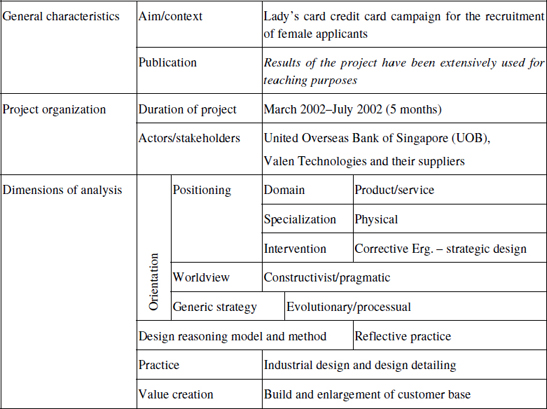
In the design process, a reflective approach was adopted in the conceptualization of the USB stick. It was incidental that Valen Technologies was able to source the electronics at a relatively low cost from a Taiwanese supplier. (At that time, in 2003, USB technology was expensive and newly patented, but as Taiwanese manufacturers were not subjected to intellectual property rules and regulations, they were able to copy unrestrictedly). The oval shape of the electronics also suggested the presence of symmetry lines, which were used as a reference for developing symmetrical plastic parts, saving tooling costs.
From a business and value creation perspective, this project can be characterized as processual. In the collaboration between Valen Technologies and UOB, direct sales and profit maximization were not targeted with the USB sticks. Instead, the business model was to use the USB stick as a means for enticing prospective female credit card customers. Moreover, the incidentally low manufacturing cost was also a characteristic of an emergent process.

Figure 5.1. Low-cost USB memory stick for enticing prospective credit card customers
5.2.2 Anthropometric considerations for embarkation and disembarkation at bus shelters (BUS SHELTER)
In Singapore, improvements on bus shelters are based on a checklist provided by the Land Transport Authority of Singapore (LTA), which was adapted from British Standards, disregarding the differences in anthropometric profiles of the population and local climate. The interface between bus shelter and bus: embarkation and disembarkation, was an important issues to be dealt with, because of the high flux of users at bus shelters in Singapore. In the period of 2000–2004, the LTA was in the process of replacing their bus shelters island wide. Hence, this anthropometric study is a project undertaken to investigate the ease of embarkation and disembarkation from bus to bus shelters and vice versa.
Most often it was necessary to take account of the tallest persons to decide on legroom or shortest persons to make sure they can navigate gaps between road curb and bus platform safely and comfortably. In terms of orientation, the predefined and research-driven nature of this project demanded a positivistic worldview toward problem solving. A corrective ergonomic approach was pursued in this project as embarkation and disembarkation from bus to bus shelters were existing and common phenomena.
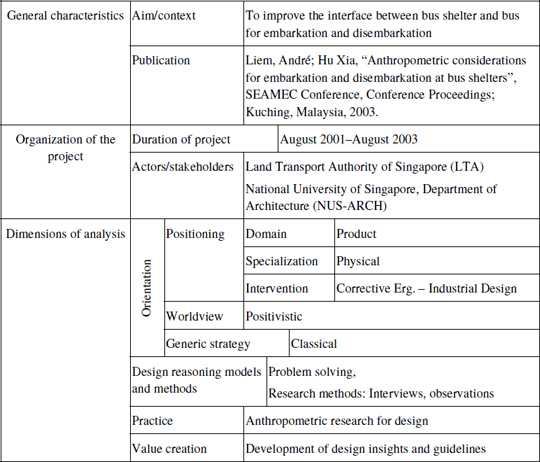
Since the purpose of this study was to investigate the proposition that anthropometric characteristics of Singaporeans affect the ease of embarkation and disembarkation from bus to bus shelters, methods such as observations and interviews were used to determine the ideal distance between road curb and bus platform.
As research dominated the practice component in this project, recommendations to enhance the design of bus shelters were derived from overall static anthropometric data of the distances between curbs to bus platforms. One hundred and twenty healthy subjects participated in anthropometric measurements. Results indicated that although embarkation showed a laterally inverted relationship with disembarkation, assumptions that body movement mechanics are the same for both embarkation and disembarkation should not be made. Derivation of the “recommended” distances from the static and sampling stick figure was accomplished by considering maxima, minima and general recommendations from literature. However, because of the complex interaction between the various dimensions it was very unlikely that the “recommended” distances would prove to be entirely satisfactory in practice. From a value and stakeholder’s perspective, the outcome of the research contributes to architects’ and LTAs’ insights in designing universally accessible workshops.
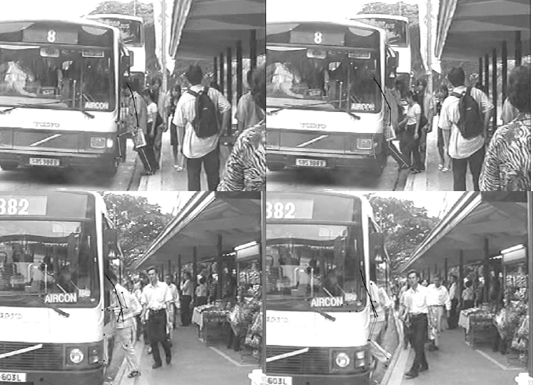
Figure 5.2. Covered video observation still capture with stick figure superimposed on user
5.2.3. Digital human models in work system design and simulation (DHM)
This work presents the application of digital human models in the simulation of downtown baggage check-in system at City Hall Mass Rapid Transit (MRT) station in Singapore. The challenge was to integrate the simulation of the personnel, technical and environmental subsystems into one computer model, which allows researchers from different disciplines to easily understand and discuss the system design. The application of digital human modeling also introduced another perspective to describe the body ellipse theory and queuing level-of-service standards. Body ellipse templates and queuing level-of-service standards were applied to locate and determine workspaces of the digital human models in the air passengers’ check-in queuing simulation. The locations of human models, instead of being manipulated by the hinge points on the bodies, were manipulated by virtual points such as the quadrant points of the ellipse outside the body. Their interpersonal space was therefore decided by the clearance between the quadrant points of the body ellipses. In parallel, a human model with the baggage/trolley can be considered as one integral block. They were positioned and managed by manipulating the endpoints on the boundary lines of the block.
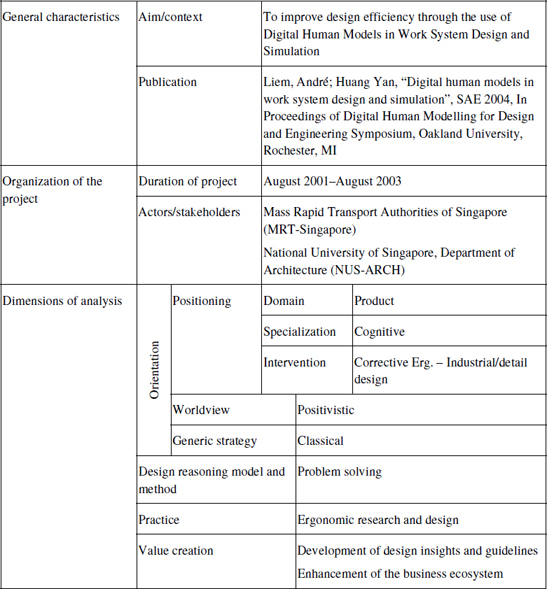
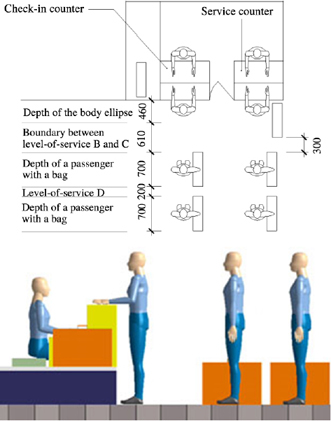
Figure 5.3. The simulation of check-in queues at the Singapore MRT station
The orientation of this project was based upon a positivist worldview, where classical and problem solving principles were adopted to correctively intervene in the ergonomic (re)design using work system simulations involving human models and objects. In terms of methods and tools, the use of CAD made it relatively convenient to manipulate the spatial relationships among the digital human models, the check-in facilities and the workplace as well as the external environments.
Considering practice, researchers, designers and other stakeholders with different backgrounds collaborated in the design of a downtown check-in work system. Collaboration wise, the use of digital human models would be a suitable platform to design, assess and communicate the project. The CAD simulation, which integrated subjects, check-in facilities, and the MRT station workplace, created a valuable platform for decision makers and stakeholders with respect to understanding and communicating the flow and mechanisms of the work system.
5.3. Analysis of cases within preventive ergonomic intervention
In this section, the following cases will be discussed within the context of corrective ergonomic intervention:
- – mail production: the Norwegian Postal Service (NPS);
- – classroom system for elementary school pupils;
- – interior concepts for small space living;
- – interior customization of Singapore fast-response police car;
- – rucksack bag design to facilitate optimum loading.
5.3.1. Mail production: the NPS

In the NPS project, a systems approach was implemented in the design of a mail distribution service. In this project, the system is the collection of subsystems and products, whereas the structure is the predetermined and fundamental logistic framework on which this mail distribution system is based upon. The term structure is diachronous in nature, which means that the relationships are time and sequence dependent.
The aim was to expose students to complex design thinking situations at an early stage of their education. In the first stage, several system alternatives were iteratively generated and evaluated through a series of scenario and task analyses, which were elaborated into a feasible and detailed system concept.
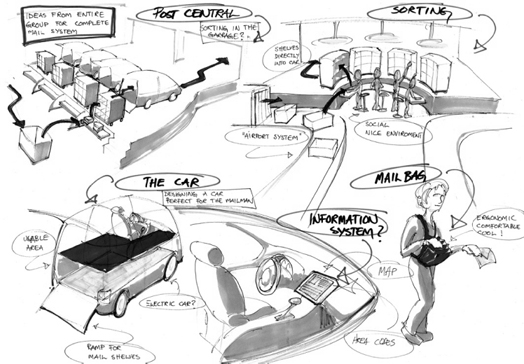
Figure 5.4. A systems approach in the development of mail production and distribution concept, considering market and technological developments
In the second stage, students further developed subsystems and products into two or three detailed design concepts. The selected design concept was then subjected to several rounds of refinement, user testing and materialization.

Figure 5.5. (a–c) Analysis and concept development of a front-seat mail sorter
The final stage was an extension of the studio, whereby selected designs were commissioned by NPS for further development and professional prototyping.

Figure 5.6. (a–c) Examples of user testing and detailing and prototype development
In terms of orientation, this NPD project was managed using structured designing processes supported by a positivistic worldview. As the problem space has already been defined, ergonomic interventions were preventive in nature. The overall system addressed many organizational ergonomic issues through people-to-people and people-to-machine interactions, whereas subordinate systems and products were either physically or cognitively rich in content.
Building upon Savransky’s [SAV 00] systems thinking approach, complex design projects involving many elements and stakeholders can be structured and managed according to a hierarchical and systematic way of project organization.
Within the overarching NPS mail production system, such a systems thinking approach can be an effective generator for extending the creativity space leading to the creation of ancillary and complementary design projects as well as broadening the network of stakeholders.
In terms of value creation, cost savings and profit enhancement for the Norwegian Postal service have been targeted.
5.3.2. Classroom system for elementary school students (Classr. Sys.)
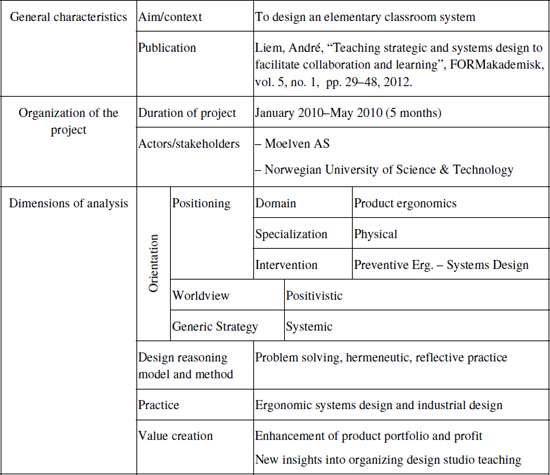
This project shows the design of an interior classroom setup for elementary school pupils using a system design perspective. In the product conceptualization and detailing stages, each group member took responsibility of a system element. In general, this group, comprising second- and third-grade design students, was successful in determining the system as well as the shared boundaries among the elements.
Strong leadership qualities among the third-grade members contributed to the clarity of design tasks. However, in the detailing and materialization stage, more time and effort than expected was spent in fine-tuning and making sure that the elements interact in a coherent manner. This demonstrated the presence of an overcompassing iterative process between system and product/element design.
A strict design process supported by a problem solving and design reasoning attitude was essential to achieve the design objectives within a systemic strategic context [SIM 96, WHI 01]. Also, a positivistic philosophical worldview was adopted in the planning and structuring of the vertical studio project to facilitate a methodology based upon a hierarchical mentorship-driven way of learning. Hereby, the interactions among group members, teachers and collaborating companies facilitated “reflective” [SCH 95] and “hermeneutic” [BAM 02, SNO 92, DAR 79] thinking to complement a problem solving oriented way of designing. In terms of practice, ergonomic systems design and industrial design contributed to the structured planning of the vertical studio. Value is created through the enhancement of Moelven’s product portfolio and profit as well as new insights into organizing studio design teaching.
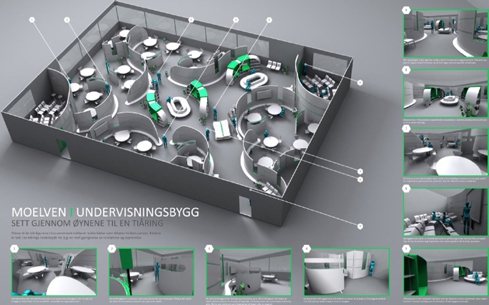
Figure 5.7. An example of an interior classroom setup for elementary school pupils, designed from a systems and product perspective
5.3.3. Interior concepts for small-space living (ICSSL)
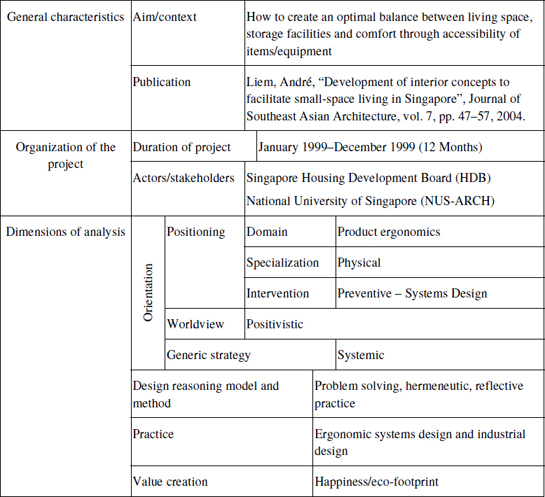
Increasingly, indented walls and higher ceilings are becoming more common in the construction of apartment housing in Singapore. These higher ceilings and indented walls created opportunities in the development of interior concepts for small-space living and Do-It-Yourself (DIY) furniture concepts. Instead of removing non-supporting walls, which is a costly exercise, one alternative for space creation is to make full use of the intricate corners, indented spaces (Figure 5.8) and if possible, internal height of its units. For example, regarding the 130 cm long IKEA Lack shelves, the buyer had to shorten the shelves (by sawing) to fit them into a 120 cm wide indentation. This was a tedious and time-consuming task, and the construction of the shelf itself was significantly weakened.
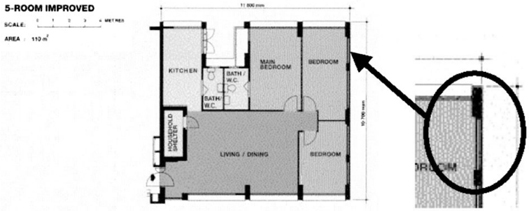
Figure 5.8. An example of indented walls in Singapore apartment housing
A flexible shelf system (Figure 5.9), which can be extended in length and depth, was proposed to optimize the space in-between indented walls. The design was based on a mechanism whereby standard parts slide among each other. This sliding mechanism, with the possibility of adding standard parts, allows the shelf to form any desired length–width ratio, meeting the need of exactly fitting the shelf into any width of indented wall. In this way, the sides of the indentation can also be used to provide a supportive function, for example to keep books from falling sideways. Each shelf is supported by internal extendable metal bars, which can be adjusted according to the desired depth (see illustration).
A preventive ergonomic and systems design approach has been adopted in the design of this piece of furniture. As the physical context (interior environment) and presumed lifestyles have been determined, this project can be characterized as systemic. Structured problem solving processes and methods were used, complemented by hermeneutic and reflective dispositions in design reasoning, because of the project’s systemic nature. Complementary to its constructive and ergonomic focus in the project, the designer aimed to develop interior solutions that are aesthetically pleasing, affordable, high quality, space efficient and easy for the consumer to install (DIY home solutions).
In this interior design project, a systematic design process has been used, which is very much context driven. The value in such a systemic project is twofold. In terms of the design solution, it advocates collaboration between industrial designers, interior designers and architects. With respect to design thinking, this project contributed to students’ awareness and sensitivity toward appreciating certain cultural contexts.
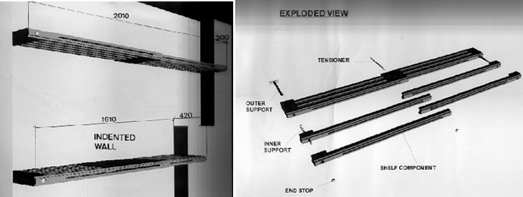
Figure 5.9. The “flexible shelf” consists of standard components to be assembled to achieve any desired width–length ratio
5.3.4. Interior customization of Singapore fast-response police car (ICSFRC)
In 2001, the Singapore Police Force (SPF) launched initiatives to improve and enhance the installation and use of equipment to optimize its fast response operations using police patrol vehicles with in-vehicle information and communication systems. Fast response cars, such as ambulances, fire engines and police vehicles, respond to emergency hotline (999 in Singapore) calls and all incidents reported by members of the public and Police Head Quarters.
Mandatory elements include the positioning of an on-board computer terminal and keyboard, radio and data transfer communication equipment in the front area of the vehicle, as well as efficient storage of other equipment and tools required for fast-response operations, such as bolt cutter, roadblock signs, riot shields, etc., in the rear area of the vehicle.
In the design and development of special vehicles, such as police cars, fire engines and ambulances, two different approaches can be identified in the interior design and customization of these vehicles. The first is defined as vehicle integrative customization and the second as vehicle adaptive customization. Integrative customization in vehicle design is the implementation of various equipment and devices without compromising on the existing features and space. It is only practically achievable when the design, fabrication and installation of the customized features have been completed in concurrence with the manufacturing of the vehicle itself. Adaptive customization in vehicle design, on the other hand, can be implemented during or at any stage after the vehicle is manufactured and operational. However, to achieve effective and efficient ergonomic usage is a complex exercise. Mechanical possibilities and constraints, inherent in the vehicle, determine the customization quality, resulting in adaptive design solutions which may vary from a crude add-on to a neatly hidden solution.
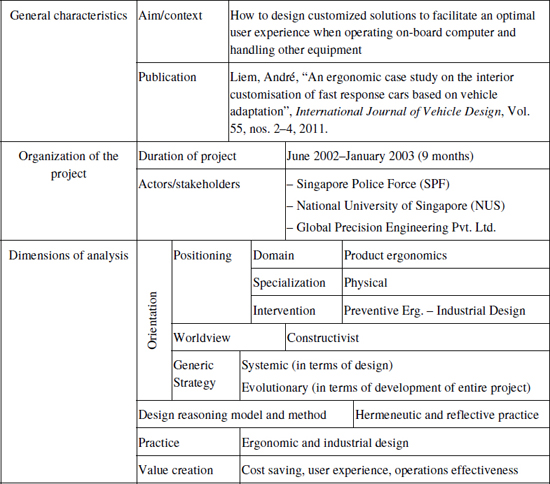
In this preventive ergonomic design project, adaptative customization has been chosen as an orientation to enhance the interaction among the electronic communication devices, co-passenger and driver (Figure 5.10), as well as to facilitate the retrieval and storage of equipment and tools in the rear interior (Figure 5.12). A constructivist worldview aligned with systemic ways of strategizing has been adopted in the design of the interior. Prior to the commencement of the project no structured design methodology was proposed. Instead, a reflective practice-oriented approach was adopted in the conceptualization and detail design of the interior customization. Foam and cardboard models (see Figure 5.11) were used to obtain better knowledge on how the electronics, equipment and tools need to be arranged in a constrained space with respect to the user. This technique provides sufficient flexibility in the exploration of concepts and the performance of user trials [STA 98].
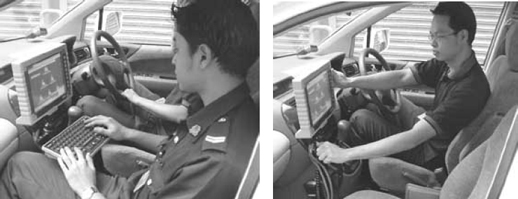
Figure 5.10. Interacting with electronic on-board communication equipment in the front interior of the vehicle

Figure 5.11. Foam models to explore the positioning of equipment in the front and rear interior of the vehicles
The final outcome showed that both design solutions for the Volvo and Mitsubishi have complied well with the ergonomic and on-the-road driving requirements, set by the SPF. However, the Mitsubishi performed better than the Volvo, as the spacious rear interior of the first provided a more ideal situation for retrieving and storing equipment. Regarding the workspace in the front of the vehicles, no significant differences have been observed in terms of interactions among driver, co-passenger and equipment.
The systemic nature of this project had an influence on the cost and value of the end product. The SPF purchased the electronic on-board equipment without consulting and negotiating with Volvo and Mitsubishi. This has led to a situation where both car manufacturers refused to undertake an integrative customization exercise, mainly because of responsibility issues. To highlight this responsibility issue, “Who will be responsible if the electronic equipment does not function or the vehicle itself encounters complications? Is it the car manufacturer, SPF, the people who install the equipment, or the suppliers of the electronic equipment?” In this case, the SPF was referred to independent subcontractors and designers for the customization project. This project is a clear example where the main actor (SPF) took an evolutionary approach, without considering the collaborative contexts of the stakeholders
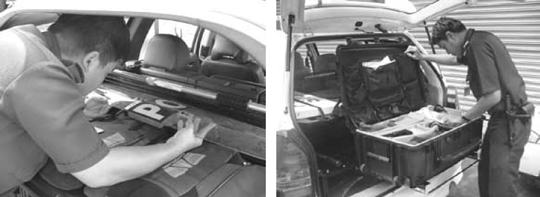
Figure 5.12. Retrieval of equipment form rear-interior of Mitsubishi and Volvo
5.3.5. Rucksack bag design to facilitate optimum loading (RBD Karrimor)
Through a collaboration between Robert Feeney Associates (RFA) and Loughborough University of Technology, a rucksack bag for long distance hikers was designed for Karrimor International. Since the harness was already completed, the focus was on how to facilitate optimum loading and unloading of items. Accessibility, space optimization, comfort, stability and maneuverability and applicability in different contexts were key issues to be considered. The result was an integrated solution of a main backpack and a daypack. During long distance traveling, both packs merge into a uniformed holistic form. In a situation, when the traveller has found him- or herself a base accommodation and intends to make day trips, the daypack can then be used separately.
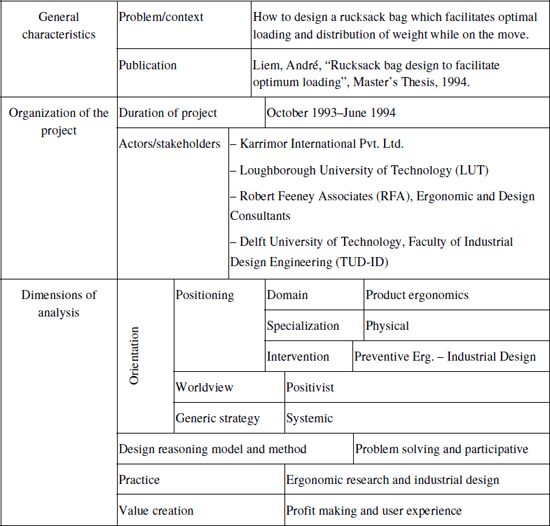
To achieve optimal comfort and performance, anthropometric experiments were conducted with respect to loads carrying under fixed laboratory and in-field conditions. The orientation of this industrial design project was based on a preventive intervention within the domain and specialization of physical product ergonomics. The emphasis on research indicated the positivistic nature of this project. A structured design approach was adopted to craft the problem definition and design requirements, as well as prescriptively suggest optimal ways of how to pack a backpack in a systemic context. Formal anthropometric and interview methods were used to gain new knowledge about loading, load distribution and load carrying, which were adopted to a certain extent, interviewed users were more involved than was expected and participated by giving concrete design suggestions.
In term of practice, this project showed how a designer dealt with a well-defined project brief, experimentation, testing and the management of quantitative data as a resource for hands on designing. Valuewise, additional profit for Karrimor International was pursued through continued research and project work in user experience design by Loughborough University and RFA.
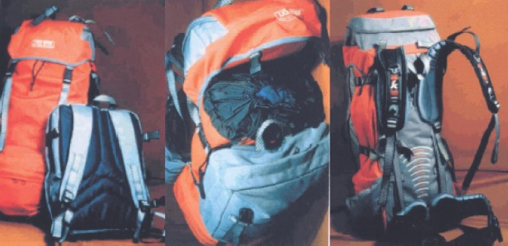
Figure 5.13. Rucksack bag design to facilitate optimum loading
5.4. Analysis of cases within prospective ergonomic intervention
In this section, the following cases will be discussed within the context of prospective ergonomic intervention:
- – product planning versus product positioning;
- – monitoring fish health;
- – development of culture-driven design concepts;
- – CAD as an idea and concept generation tool in the early design stages.
5.4.1. Product planning versus product positioning (PP versus PP)

From 2005 to 2013, 8–10 established Norwegian firms were annually involved in a four-year collaborative strategic design project. The strategic design project was divided into two stages: product planning and management and industrial design. In groups of two or three, students were required to mimic design consultants.
In recent years, an alternative route to goal finding leading to more detailed directives in formulating the design brief was suggested through the implementation of product/service positioning maps for determining “value creation” opportunities [CAG 02]. The “how to” design was introduced as a response complementary to the “what to” design as framed by Ansoff’s product-market-technology model [ANS 68]. The analysis of nine recent strategic design projects showed that visionary capabilities were important in generating radical and incremental innovations. As shown in Figure 5.14, a “new product–existing market” strategy was targeted in five of the nine projects, whereas two projects focused on creating a “new market for existing products and technologies”. Two other companies embarked on a “natural” diversification strategy, because they were contract manufacturers and did not have any background and expertise in developing their own core products. Design goals were determined through discussions among company management and design students, driven by a conjecture–analytical design approach. When adopting Cagan and Vogel’s positioning map, all low and high technology projects were categorized in the high style (ergonomics and form) quadrants (Figure 30B).
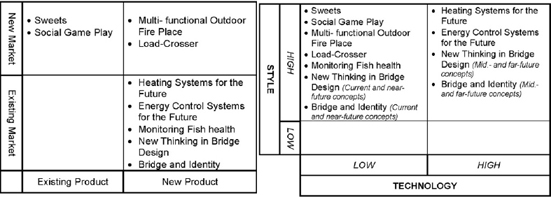
Figure 5.14. a) Positioning of strategic design projects on product-market matrix; b) Positioning of strategic design projects on Cagan and Vogel’s positioning map (2002)
In terms of orientation, students were subjected to a product planning and management process, where they had to follow a systematic innovation-step model that guided them to determine their design brief [BUI 87, BUI 96]. The deliverables were innovative products and services. This project was driven by prospective intervention, which is dependent on the type of company collaboration, required physical, cognitive and/or organizational ergonomic specialization. Based on a positivistic worldview, the project aligns with a classical or systemic strategy, dependent on the contextual influence within each type of collaboration.
Concerning methods and practices, a structured problem-solving approach throughout the product planning and industrial stages was complemented by participative design interventions. The purpose of these interventions was to boost divergent creative thinking, find focus, as well as to align interests among stakeholders. Moreover, it can be clearly seen that prescribed methods are applicable to determine the innovative content of design projects, either from a “what” or “how” approach in both positioning frameworks. Hereby, social, economic and technological trends formed the basis for strategic thinking and innovation.
The value of using product planning and product positioning methods lies within the positivistic realm, mainly focusing on the fulfillment of economic needs. While taking into consideration user, organization and business ecosystem levels of involvement, the educational relevance of using these frameworks is to make students understand how to develop a structured business context for their project on which they can build further upon to be more specific in their goal product planning and designing activities.
5.4.2. Monitoring fish health project (Fish Health)
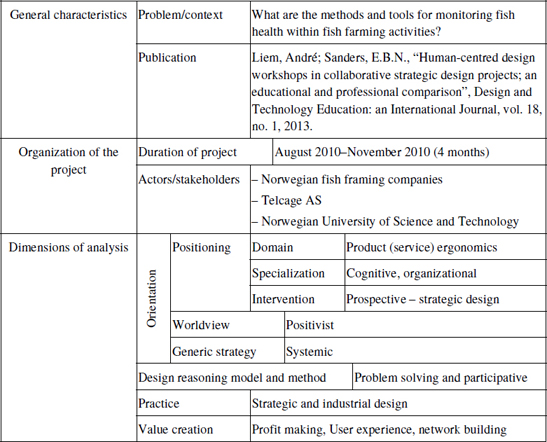
Cocreation workshops focused on the context of “Sea-based Fish-farming”, where students addressed problems and solutions related to monitoring fish health for an information service provider. The objective was to reveal interesting problem areas and business opportunities for the company and its stakeholders and to encourage these participants to be creative and generate new ideas. The company was a service provider, developing information and communication services (including the needed communication infrastructure) for the off-shore fish-farming market. Services were given on a subscription basis. Since the benefits of the services were not fully understood by the market (i.e., the market is “under developed”), it has been important for the service provider to develop the services in close co-operation with the users and other stakeholders.
The first workshop with “consumers” revealed existing knowledge and concerns around fish health related to the fish farming industry. The second workshop focused on idea generation and contextualization of roles and responsibilities, especially those of the service provider (Figure 5.15).

Figure 5.15. Workshop with “stakeholders” revealing existing knowledge and concerns around fish health
Ideas that emerged from the sessions were clustered into five categories. These were technical solutions, user-friendliness in surveillance, preventive and curative health care using telemedicine, documentation and facilitation of purchase through information. The conclusion from the idea development exercise was to make it easier for the fish farmers and veterinarians to detect illnesses early and decrease the damage, as well as to avoid financial losses connected to massive fish health problems.
In the third workshop, as new technologies (sensors, communication technology etc.) and new ways of working were introduced, needs and wishes of the different stakeholders connected to activities around fish health were further explored, which led to new opportunities discovered attached to fish health.
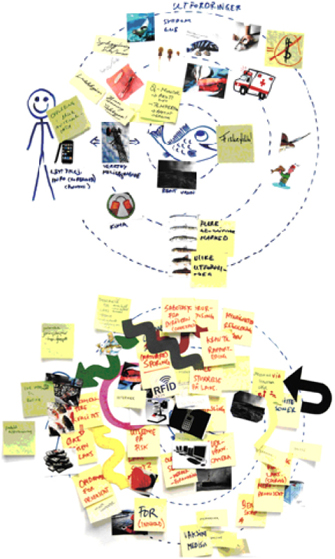
Figure 5.16. Use of cocreation tools and methods to map out the context and generate ideas
This project is predominantly service oriented. Ergonomic focus was on cognition and organization, as solutions were predicted to be in the field of user-interface design. Since the market is underdeveloped but the context clearly defined, a participative, structured problem solving approach has been practiced in the form of consecutive workshops as described above. Hereby the designer(s) acted as (a) facilitator(s) and introduced cocreation methods and tools to the various workshop participants. This approach aligns with a systemic generic strategy. From a value creation perspective, the workshops have provided useful insights for idea and concept generation in terms of technology implementation, content and service provision for a fish health surveillance interface. Through these insights, two main developments were ascertained:
- – the usability and accessibility of the interface have improved through complementary services;
- – technology development has led to increased information flow among stakeholders and complementary services.
5.4.3. Development of culture-driven design concepts (Culture DCC)
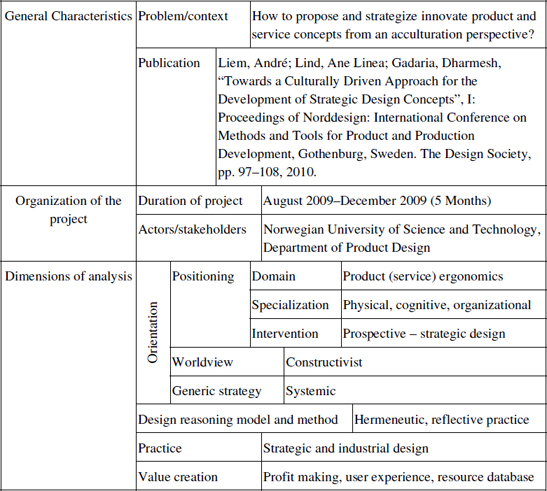
This project proposed acculturation theories for designers to undertake a more comprehensive external analysis in the product planning stages of the innovation process. The concept was based on the assumption that extreme trends and developments in societies’ political, economical and social situation are usually not favorable, and therefore perceived as a motivator for initiating incremental or radical product/service ideas. Several case studies have illustrated the difficulties in changing social, political and economical developments overnight in a society, and demonstrated the potential role of design in improving these difficulties through innovative design concepts. A bottom-up analysis of cases resulted in six preliminary categories, and function as a guide for a broader and more reflective approach in product planning and goal finding. These categories are as follows:
- – healthcare and elderly care;
- – working and living;
- – education and manpower development;
- – purchase of food, products and services;
- – mobility/transportation of goods and people;
- – interaction and communication.
This shows that a cultural approach toward external analysis and product idea generation in the front-end of innovation (FEI) can be instrumental in the generation of innovative system and or product ideas to improve quality of life and service not only in developing but also developed nations.
In terms of orientation, the diversity of case studies has demonstrated that a systemic approach based on culture and context toward strategic design should be further explored in the construction of prospective product service systems in the FEI. From a reflective and hermeneutic design reasoning perspective, these various case studies have illustrated the potential role of design in improving the negative aspects of these developments by understanding extreme cultural trends as well as the potential for acculturation. Potential domains for innovation are within the realm of product/service ergonomics with specializations either in physical, cognitive and/or organizational ergonomics.
With respect to method and practice, mapping case studies on a bipolar scale, which illustrates extreme cultural trends and developments in certain societies, facilitates the search for new product ideas in the FEI. Furthermore, the results of these mapping exercises can be consolidated into a resource of diverse cases, which help to bottom-up craft out a database of cases for product planning and goal finding. This database of cases, which is a valuable asset, needs to be refined and updated from time to time to maintain relevance as a source for external analysis in the generation of innovative system/product ideas.
5.4.4. CAD as an idea and concept generation tool in the early design stages (CAD Tool)
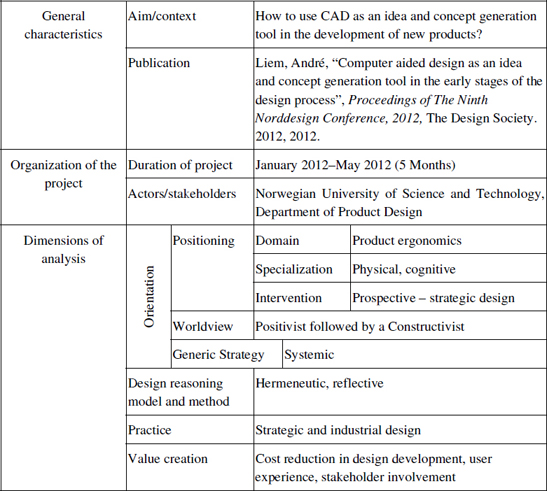
The existing tension field on When, Where and How to use conventional design representations versus CAD is becoming more and more prevalent. This research project attempted to argue that in certain circumstances digital visual representations (CAD) are more effective in the early creative idea and concept generation stages of the design process compared to sketches and drawings. In other words, intensive reflective and processual visualization activities, which immediately render feedback in computer media, encourage the designer to generate images more frequently and more precisely in his/her mind, compared to conventional media.
The above phenomenon has led to discussions around two factors, which redefine the value of CAD in an educational context. These factors are as follows:
- – type of students admitted according to academic inclination;
- – type of design program.
Results have shown that because of their sound academic abilities, students, who were admitted only upon good grades, demonstrated a strong aptitude toward learning different CAD systems. However, they were generally weak in (manual) sketching and drawing. This is explicitly shown in interactions among educators and students in the early stages of the idea development and concept generation stages where crucial stages of exploration and reflection are visualized by surprisingly well-developed CAD drawings/models, rather than manual sketches and drawings.
An interesting correlation can be seen between the type of design program and evangelized processes and methods. Industrial design engineering programs, who advocate a structured problem solving process and methods, based on analysis–synthesis, are very much inclined to promote CAD as early as possible in design and materialization activities. The inherent tension between CAD and conventional sketching, which is caused by the different perspectives on “what design is about”, should encourage design programs to rethink and re-evaluate their educational objectives, in conjunction with which design tools are to be emphasized or not, in terms of design knowledge and skills transfer.
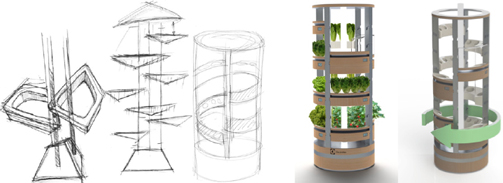
Figure 5.17. Example of a design submission, where the student demonstrated poor manual representation, but good CAD modeling skills
In terms of orientation, a positivistic worldview was initially adopted, where students, who participated in the Electrolux Design Lab 2012 competition, argued for the existence of a problem and attempted to solve it from a contextual and systemic viewpoint, based upon the theme, “design experience”. In conjunction with the theme, a specific context was explored, researched and analyzed from Social, Technological, Economic, Environmental and Political (STEEP) perspectives. Most students were able to formulate clear consumer insights using a structured problem solving approach. However, methodologically and practice wise, students turned to a reflective mode of thinking. Instead of demonstrating design flair through the comprehensive and explicit representation of ideas and concepts, they developed ideas and initial concepts inwardly through low-quality thumbnail sketches and much verbal explanations. When the design concept became more concrete in their minds, these students quickly readopt a structured problem solving approach by extensively using digital design tools in the conceptualization, detailing and materialization stages.
The value of using CAD in the early design stages may lead to cost reduction in the design process through new ways of visually representing designs convincingly accurately and fast. Furthermore, the earlier CAD is adopted, the earlier stakeholders can be invited to participate in the design process.
